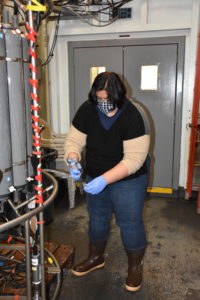
After the successful fourth and final mobilization for VISIONS’21 we, new and old participants alike, were excited to be heading out to sea once again for Leg 4 on the afternoon of August 25th. New participants joining the ship for this leg include the UW Director of Cloud Computing, a SETI Institute scientist, a NASA JPL post-doc, a Victoria University of Wellington/NIWA graduate student, a Citrus College student, and three UW VISIONS’21 students. They joined two UW undergraduates and our resident artist Cathe Gill, who also participated on Leg 3.
Our first stop for Leg 4 was the Deep Profiler mooring at the Endurance Oregon Offshore site, where the ROV Jason swapped out the deep profiler vehicle (wire crawler) and gave the mooring wire a good cleaning. Removing the marine life and other detritus that accumulates on the wire over the year makes it easier for the new profiler to make its ascent and descent through the water column. Despite our annual maintenance, the Deep Profiler Mooring remains a host to an array of exciting biology. Plumnose anemones and crinoids settle on the floating ball at the top of the mooring and schools of fish swarm around the mooring wire in the water column.

After the wire crawler that has been out for a year was recovered, Julie Nelson and a team of students did a late-night data verification CTD cast. During the cast a ring of bottles (Niskins) is lowered from the ship and used to capture water at various depths. These water samples are processed for oxygen, carbon dioxide, chlorophyll, salinity, and nutrients that can be compared with the similar measurements from the shallow and deep profilers.
Before dawn had even broken, we began an approximately 18-hour transit out to Axial Seamount, where we will conduct a majority of our operations this leg. Our first stop will be at the base of the seamount to swap the deep profiler there. Then it’s on to the caldera and the various hydrothermal vent fields and instruments deployed at them.
